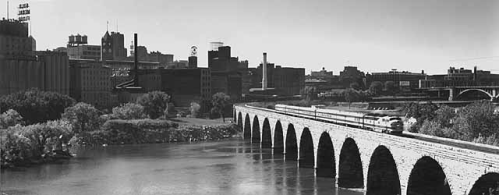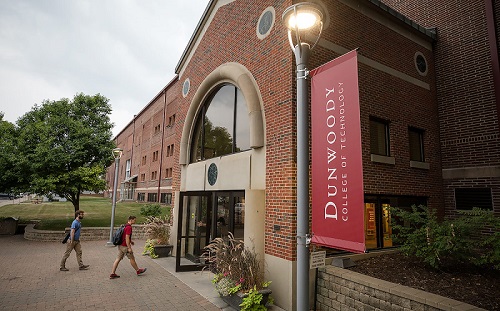Article by Becky Fillinger, photos provided

Did you know that the Mill District is home to a business that takes on the toughest work in technology – creating trustworthiness in critical systems, for clients like NASA and the Space Development Agency? Shpat Morina, Galois' Director of Business Development and IR&D (Internal Research and Development), told us about their very important and impressive work happening at 111 3rd Avenue S.
Q: I really like the company’s tagline – software to solve your hardest problems. It makes me believe that at Galois you don’t shy away from difficult business problems. Talk to us some more about that notion.
A: We definitely don’t shy away from that, quite the opposite.
Our researchers love that they get to tackle questions for which there literally might not be an answer and for which they might fail. We take on work at the bleeding edge, because "What if?" is a compelling question to research scientists. And when we do solve a problem, it's usually very significant. For example, making it cost effective to apply the kind of technology that used to be reserved for expensive space missions to secure everyday encryption software that secures internet traffic. Or, our work at the bleeding edge of human-machine teaming (helping people and AI learn better from each other and work better together) and digital engineering (a kind of digital cartography for complex systems).
But the unifying umbrella, and what universally drives the R&D we do is this notion of creating trustworthiness in critical systems. A critical system is one that simply cannot fail without catastrophic consequences. A plane’s software can’t cause it to just fall from the sky, for example, or the encryption software that protects extremely sensitive data can’t be flawed and exploitable by an adversary.
Our work largely focuses on developing tools and approaches to get an ever higher level of assurance of trustworthiness, often via rigorous engineering and mathematical verification, in systems that simply cannot fail. In other words, it is all about ways to make sure that really important systems work so reliably and securely that you could, in theory, bet your business or even matters of national security on their trustworthiness.
Q: Why does Galois have an office in downtown Minneapolis? Is it driven by your client locations? Could you please tell our readers about the technological innovation happening in our midst?
 Shpat MorinaA: Well, getting a bigger presence in downtown Minneapolis isn't just about moving offices. We acquired Adventium Labs in late 2022, and they were based here. So, the move was primarily driven by the merger and wanting to be intentional about the environment that our team operates in. Our clients are nationwide, so location isn't that big a factor in this case.
Shpat MorinaA: Well, getting a bigger presence in downtown Minneapolis isn't just about moving offices. We acquired Adventium Labs in late 2022, and they were based here. So, the move was primarily driven by the merger and wanting to be intentional about the environment that our team operates in. Our clients are nationwide, so location isn't that big a factor in this case.
As for the tech innovation happening here, it's frankly amazing. For context, as the sheer amount of code that makes up software gets bigger and bigger, and as things like factories, airplanes, power grids are increasingly intertwined with software systems, the result is an environment that can be very complicated and difficult to keep reliable and secure. Adventium Labs was at the forefront of creating tools that help navigate, update, and secure complex cyber-physical systems, and we’ve fused this strength with Galois's historical focus on trustworthiness. It's creating an even more powerful force in the world of mathematically-principled computer security & reliability.
Projects like FRIGATE, RMF, and CAMET, among many others, had their genesis here in Minneapolis. These are tools that aim to do audacious things like making space exploration safer. And that’s a very small taste of the impact we get to make.
Q: Why the name Galois for the business?
A: We named our company “Galois” as a nod to the 19th century French Mathematician Évariste Galois. Some of his contributions are now fundamental to computer science and have applications in the work we do. His contributions are even more remarkable when you consider how much he accomplished before his untimely death at 20 in a duel.
His work, specifically his development of Galois theory, hinged on the idea of finding new solutions to problems by changing the way you look at them. We see a direct parallel to our work in computer science. Not to get too nerdy, but a lot of our work involves reworking clients' problems from domains where there is no straightforward solution into alternate but equivalent mathematical domains in which solutions do exist. We like to think that, in our own way, we're carrying on that innovative spirit. Minus the duels.
Fun and obscure fact, the original name of the company was Galois Connections. It turned out to be a little too technical. It turns out that, to a lot of people in the early 2000s, Galois Connections sounded like a dating company :). We eventually shortened it to Galois.
Here's a bit about Evariste if you're interested! https://galois.com/team/evariste-galois/
Q: So happy you’re not dueling in downtown Minneapolis! Galois does a lot of work for the federal government. Does it ever bog down your research by taking the time to comply with the contractual compliance terms?
A: Working with the government comes with its own set of requirements, but I wouldn’t say it bogs down our research at all. When you think about the impactful nature of the work, it really is important to get things right, and not just technologically. So, we’ve built a culture of care and of ensuring trustworthiness that isn’t siloed in the technical team alone.
That, plus the level of operational support we have to make sure that all aspects of the work are taken care of, makes the actual R&D work fun.
And after all, if we get to work with NASA to come up with better failure recovery for future manned missions, for example, or get to work with the Space Development Agency to explore better ways to secure information in space, what’s a few additional requirements to meet? :)
Q: You mention on X that "while most engineers and scientists join Galois to be part of a company that conducts groundbreaking research, for our unique culture of collaboration, or for the great benefits and work-life balance, there’s a lesser-known but equally exciting perk of working at Galois: participating in the creation of spinouts." What’s a spinout?
A: A spinout is basically when we create a new, independent company to take a technological opportunity that arises from our R&D, and turn into a full-fledged supported product or set of services with its own specialized support and development team. We do this instead of changing our own company focus or trying to juggle various product lines.
Why spinout? Well, it protects the special creative culture and flexibility we need for our core R&D work, which isn't quite the same as the flavor of speed and expertise needed to run a product-focused business. And our clients get to see the R&D they support become more applied and deeply useful to their mission in a different way. Plus, it's exciting! We get to see our breakthroughs making a real-world difference, which is a huge draw for many of our team who moved here from academia.
And let's not forget the financial aspect – since we're employee-owned, we all have a stake in the success of spinouts. Besides, it's a clever way of managing risk, because we only invest what we can afford to lose. It's a win-win-win situation, really, for Galois, our clients, and the new spinout.
P.S. - We love this topic almost as much as we love the scientific work we do.
Q: Have any Minneapolis spinouts occurred?
A: Not yet!
Q: I think the Downtown community would love an ongoing Ted Talk-type event where your engineers tell us about their research and clients' problems solved - in layman’s terms – possible?"
A: We would like to make that happen. I love that our Minneapolis team is very engaged in the community and is extremely passionate about building community here, whether that be through internships, supporting student-led capstone projects, getting engaged in local events, or participating in and supporting all sorts of tech education organizations. I have no doubt we’ll come up with new ways to do that.
 Sunday, October 1, 2023 at 2:39AM |
Sunday, October 1, 2023 at 2:39AM |  Becky Fillinger |
Becky Fillinger |  Hebe TabachnikMSP Film Society proudly celebrates Hispanic Heritage Month with the 11th Annual Cine Latino Film Festival. The festival highlights the best new Latin American, U.S. Latinx, and Ibero Cinema – and it happens in our neighborhood at The Main Cinema, 115 SE Main Street. Artistic Director Hebe Tabachnik gave us her top picks for the festival. See the full line-up here and purchase tickets here. Daily parties at Pracna, food trucks and visiting filmmakers round out the event.
Hebe TabachnikMSP Film Society proudly celebrates Hispanic Heritage Month with the 11th Annual Cine Latino Film Festival. The festival highlights the best new Latin American, U.S. Latinx, and Ibero Cinema – and it happens in our neighborhood at The Main Cinema, 115 SE Main Street. Artistic Director Hebe Tabachnik gave us her top picks for the festival. See the full line-up here and purchase tickets here. Daily parties at Pracna, food trucks and visiting filmmakers round out the event. RADICAL - Cine Latino's Opening Night film is based on a true story about an unconventional teacher who resorts to creative methods to inspire in his students a contagious curiosity and love for learning and discovery. A more than healthy dose of laughs and tears is warranted!
RADICAL - Cine Latino's Opening Night film is based on a true story about an unconventional teacher who resorts to creative methods to inspire in his students a contagious curiosity and love for learning and discovery. A more than healthy dose of laughs and tears is warranted! GOING VARSITY IN MARIACHI - An unforgettable ode to identity, belonging, and resilience alongside youth Mariachi bands. Please come prepared to leave the theater singing and dancing. Mariachi of all ages are welcome! Filmmaker Daniela Quiroz will be in attendance.
GOING VARSITY IN MARIACHI - An unforgettable ode to identity, belonging, and resilience alongside youth Mariachi bands. Please come prepared to leave the theater singing and dancing. Mariachi of all ages are welcome! Filmmaker Daniela Quiroz will be in attendance. ELIS & TOM - IT HAD TO BE WITH YOU - In 1974, Tom Jobim, one of the creators of Bossa Nova, and Elis Regina, the most popular singer in Brazil at that time, met to record what would be the most iconic album of Brazilian music. One of this year’s Cine Latino's tribute to the powerful musical heritage of this magic region.
ELIS & TOM - IT HAD TO BE WITH YOU - In 1974, Tom Jobim, one of the creators of Bossa Nova, and Elis Regina, the most popular singer in Brazil at that time, met to record what would be the most iconic album of Brazilian music. One of this year’s Cine Latino's tribute to the powerful musical heritage of this magic region. THE EXTORTION - High-octane entertainment up in the skies and across the Atlantic with lots of twists and turns with unpredictable consequences makes this a great film for a fun night out with friends and family.
THE EXTORTION - High-octane entertainment up in the skies and across the Atlantic with lots of twists and turns with unpredictable consequences makes this a great film for a fun night out with friends and family. 20,000 SPECIES OF BEES - Cine Latino's Closing Night film is definitely one of the best films of the year, Winner of the Best Performance Award at the Berlinale 2023 for the eight-year-old protagonist played by Sofía Otero, 20,000 Species of Bees is an emotional and very satisfying tale about diversity, dialogue, and tolerance.
20,000 SPECIES OF BEES - Cine Latino's Closing Night film is definitely one of the best films of the year, Winner of the Best Performance Award at the Berlinale 2023 for the eight-year-old protagonist played by Sofía Otero, 20,000 Species of Bees is an emotional and very satisfying tale about diversity, dialogue, and tolerance.  POWER ALLEY - SNEAK PREVIEW! - Driven by compelling performances, energetic editing, and a dazzling score, this hopeful and spirited celebration of sisterhood and resistance in the face of Brazilian conservatism is the luminous debut feature of Writer/Director Lillah Halla and the Winner of this year’s FIPRESCI Award at the Cannes Critics' Week.
POWER ALLEY - SNEAK PREVIEW! - Driven by compelling performances, energetic editing, and a dazzling score, this hopeful and spirited celebration of sisterhood and resistance in the face of Brazilian conservatism is the luminous debut feature of Writer/Director Lillah Halla and the Winner of this year’s FIPRESCI Award at the Cannes Critics' Week.











































































